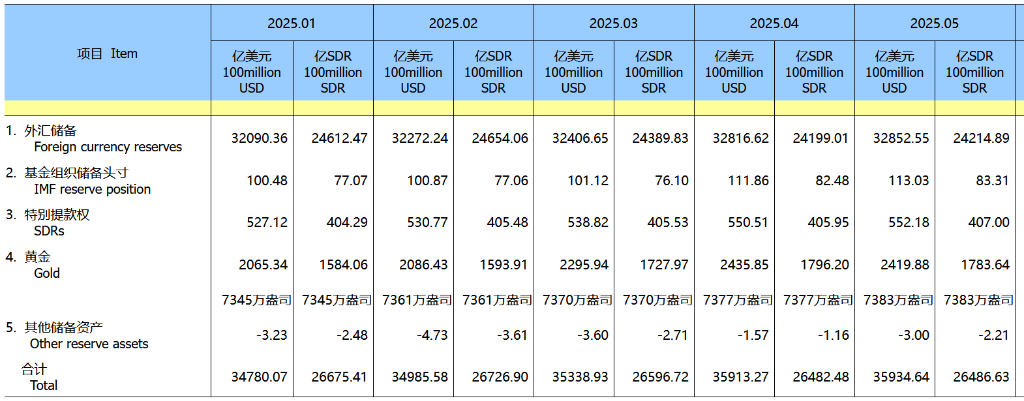
According to the latest announcements from the People's Bank of China and the State Administration of Foreign Exchange, the People's Bank of China has increased its gold reserves again, marking the seventh consecutive month of gold holdings. However, this time the rate of increase is a bit slower than before.
Specifically, China's gold reserves reached 73.83 million ounces (about 2,296.37 tons) at the end of May, an increase of 60,000 ounces (about 1.86 tons) from the previous month. For comparison, in April it was an increase of 70,000 ounces, compared to 90,000 ounces in March. It can be seen that although we continue to buy, the amount of buying each month is gradually decreasing.

At the same time, China's foreign exchange reserves are steadily increasing. This means that despite the complex and volatile global economic environment, China still maintains a sound economic foundation and a good balance of payments.
The central bank's increase in gold holdings is still the future direction
Recently, the international gold price has been like a roller coaster, rising and falling sharply, and the fluctuations are very violent. Jia Shuchang, head of research at the World Gold Council in China, pointed out that an important factor that had previously supported gold prices was the risk of a global trade war. With the substantial progress made in the high-level economic and trade talks between China and the United States, the level of bilateral tariffs has been significantly reduced, and this part of the risk premium has fallen, and investors' safe-haven demand has also weakened temporarily.
The central bank continued to increase its holdings of gold mainly because of new changes in the global political and economic situation. Especially after the new US administration takes office, the international gold price is likely to maintain a trend of easy to rise and difficult to fall for a long time. This means that from a cost containment perspective, the need to pause gold holdings has decreased, while the need to optimize the structure of international reserves has risen.
According to the World Gold Council's Q1 2025 Global Gold Demand Trends Report, total global gold demand, including over-the-counter investments, reached 1,206t in Q1, a slight increase of 1% y-o-y and the highest level since 2016.
The central bank will continue to increase its holdings of gold in the future. The main reasons are as follows:
Low proportion of gold reserves: As of the end of May 2025, the proportion of gold in China's official international reserve assets was only 7.0%, far lower than the global average of about 15%.
Enhance the credit of sovereign currency: As gold is widely accepted as the last means of payment in the world, the central bank's increase in gold holdings can enhance the credibility of the renminbi and create favorable conditions for promoting the internationalization of the renminbi.
Responding to changes in the international environment: From the perspective of optimizing the structure of international reserves and coping with the current complex changes in the international environment, the increase of central bank holdings of gold in the future is still a general direction.
Foreign exchange reserves continued to grow
Since 2025, the balance of China's foreign exchange reserves has continued to grow. In the first five months of this year, China's foreign exchange reserves increased by US$6.679 billion, US$18.2 billion, US$13.441 billion, US$41 billion and US$3.6 billion respectively.
The State Administration of Foreign Exchange pointed out that the U.S. dollar index fluctuated slightly in May, and global financial asset prices were also mixed. In this case, the combination of exchange rate translation and asset price changes led to an increase in the size of foreign exchange reserves in the month.
Wen Bin, chief economist at China Minsheng Bank, explained that the tariff situation between China and the United States eased in mid-to-early May, and the demand for the dollar in the global market weakened for a while. However, in late May, the trend of de-dollarization re-emerged due to factors such as the cold auction of US Treasury bonds and the escalation of the trade war between the United States and Europe. Despite this, in May as a whole, global asset prices rose and fell, and the support for external reserves was limited, but exchange rate changes still played a certain role in supporting foreign reserves, and finally foreign exchange reserves rose by $3.6 billion in May from the end of the previous month to $3,285.3 billion.
With the US dollar index fluctuating slightly and global financial asset prices rising and falling, the scale of China's foreign reserves did not change much at the end of May. At present, the scale of external reserves of just over $3 trillion is at a moderately sufficient level and is expected to remain basically stable in the short term. This moderately abundant scale of external reserves will not only help maintain a reasonable and balanced level of the RMB exchange rate, but also play a role as a "ballast stone" when the external environment fluctuates.
Foreign exchange reserves rose slightly, behind which is the global "policy drama"
According to the latest news from the State Administration of Foreign Exchange, China's foreign exchange reserves did not rise much in May this year, but the reasons behind it are quite interesting.
In simple terms, this is mainly influenced by the fiscal and monetary policies of several major economies, such as the United States, Europe, and Japan, as well as their economic growth expectations. Combined, these factors caused a slight shock in the dollar index, which is a measure of the strength of the dollar.
At the same time, the prices of financial assets around the world have also risen and fallen, some stocks have risen, and some bonds have fallen, showing a state of "you sing and I will appear". Therefore, how to convert the exchange rate and how to change the asset price, these two factors combine to act, and our foreign exchange reserves will go up a little bit.
Of course, external factors alone are not enough, and the key to keeping foreign exchange reserves basically stable is our own economic fundamentals.
At present, China's economy is recovering steadily, and the quality of development is also improving. Just like a ship, the engine is powerful, and no matter how big the wind and waves are, it is not afraid of bumps. It is this kind of "profound internal strength" that allows us to stabilize the market of foreign exchange reserves in the face of a complex and changeable international environment.
Jingtai Discussion: What Do Investors Think?
As investors, we can read a few signals from this:
China's economy is resilient enough: even if the external wind is turbulent, it is still stable internally. Healthy foreign exchange reserves: slightly above the level of 3 trillion US dollars, which is in the moderately abundant range, forming a strong support for the RMB exchange rate.
Equal emphasis on hedging and investment: In the context of intensified global asset volatility, appropriate allocation of safe-haven assets such as gold and foreign exchange is still a wise choice.





